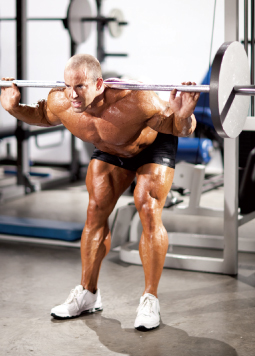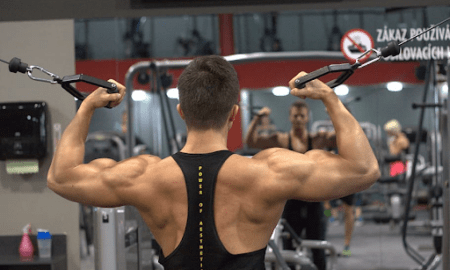 The lower back is the universal joint of the power plant. If you don’t have strong lumbars, the power generated by the hips and legs cannot be transferred upward into the back and shoulder girdle. Nor can it be sent downward through the lower back. Athletes who are serious about getting stronger understand the importance of working their lumbars hard and heavy.
The lower back is the universal joint of the power plant. If you don’t have strong lumbars, the power generated by the hips and legs cannot be transferred upward into the back and shoulder girdle. Nor can it be sent downward through the lower back. Athletes who are serious about getting stronger understand the importance of working their lumbars hard and heavy.
Strong lumbars are essential if you want to squat and pull heavy weights. Improving hip and leg strength is directly related to lumbar strength. When athletes hit a sticking point on squats, it’s often due to a relative weakness in the lower back. While their form is good and they put in the time squatting, their squat stays stagnant. That’s because their lumbars aren’t up to the task. When the lumbars aren’t strong enough, they can’t hold the proper positioning and technique suffers. Plus, they can’t generate the necessary power to grind the bar up to the finish.
The same idea holds true for heavy pulling exercises, especially explosive movements such as the snatch and clean. It is the lumbars that are primarily responsible for elevating the bar through the middle range. When it lags through the middle, there will not be a snappy finish. In addition, when the lumbars are proportionately weak, the lower back will round under heavy poundages, causing the bar to move out of the correct line of pull.
The fact that strong lumbars play a key role in squatting and heavy pulling exercises is fairly obvious, but most trainees overlook their role in all types of overhead lifts. The ability to lock out and hold a maximum-effort snatch, jerk and press is directly dependent on the strength of the lumbars. When they’re weak, the upper body will collapse, and the lift will not be made successfully.
Another good reason to make certain that your lumbars stay strong throughout your lifetime is that the lower part of the back is most frequently the one that causes problems. That’s true for the general population, where eight out of 10 adults experience some sort of back pain and 70 percent of those are lower-back issues. Well-conditioned athletes have much less trouble with their lumbars, yet that area still gets injured, mainly because its strength is not maintained in proportion to the rest of the body, and the weakest-link principle steps in and says hello.
There are many exercises that anyone can do to increase lumbar strength. They require very little in the way of equipment and can be done alone—without any assistance. That’s the good part. The flip side is that any exercise specifically for the lower back has to be worked very hard. Merely teasing the lumbars with light weights just doesn’t feed the bulldog—which means those exercises are not much fun to do. In fact, they are typically the most hated movements in any strength program, but there is a truism in strength training: Those who are willing to do the tough exercises will become the strongest athletes.
The two best primary exercises for the lower back are good mornings and almost-straight-legged deadlifts. Good mornings are often called “tomorrow mornings” and for good reason: When you push them to the limit, as you should, your lower back will report in the next morning. If your back doesn’t complain, you didn’t work the good mornings hard enough. Plain and simple.
Be forewarned. There is absolutely no way to make a good morning workout easy—unless you stay with light weights, and that just doesn’t get the desired results. I frankly admit that I do not like them, but I do like the results, and so I do them every week. They have a positive influence on all of my exercises and keep my lower back from aching in a bad way. I know that when athletes are dedicated to getting considerably stronger, they don’t mind doing the demanding exercises. They welcome them.
There are several ways to do good mornings: with a flat back, with a rounded back and while seated on a bench. If, when you attempt to do a good morning with your back rounded, you experience a sharp pain and it’s not from the exertion itself, switch to the flat-back version. Both forms will give you results when you work them hard enough. The seated version is much less demanding, and I only recommend it for trainees who are unable to do standing good mornings due to some injury. I do, however, insert them into all athletes’ programs periodically to build some variety into the lower-back routine.
To perform a standing good morning, take the bar off the rack and make sure that it’s locked tightly down into your traps. That’s one of the most important points. Should the bar move around, even slightly, it will cause pain in your neck and lower back. That will be more irritating than doing the exercise itself. Shrug your traps and pull the bar down into the muscle, keeping it locked there.
Step back, set your feet a bit closer than shoulder width, and turn your toes in slightly. Never have your knees completely locked when you work your lower back. It places far too much stress on the hamstrings and can result in a pulled muscle. Push your feet down into the floor. That helps tighten your hips, legs and back, and it helps you control the bar better. Now bend forward, making sure that your hips stay locked in the exact same position throughout the movement.
Try to place your chest on your thighs. You may not be able to do it right away, but with repetition you will. I’ve had athletes who could look back between their legs at the bottom of a good morning. Maintain a smooth, controlled movement as you bend forward and recover. No herky-jerky. You will also find that when you go lower, you will get a sort of recoil out of the bottom, which helps. Reset, and do the next rep.
For the seated version brace your feet firmly when you sit on the bench. Try to touch your chin to the bench. These are much easier than standing good mornings, so you can handle more weight. Unless you can’t do standing good mornings, use the seated version only occasionally. Harder is always more productive than easier in strength training.
I like to alter the sets and reps every other week. Week 1: five sets of eight; week 2: four sets of 10. While there’s very little difference between the two workouts, for some reason the body responds to the slight change in a positive manner. When you do eights, use five more pounds than when you do 10s.
Here’s my rule of thumb for how much weight you should use on this exercise. Your eventual goal should be to handle 50 percent of your best squat for eight reps. So, if you are squatting 400 pounds, your last set of good mornings will be 200 pounds. While that may seem like a lot of weight, it isn’t. If you include good mornings in your program from the very beginning, it will not be difficult for you to maintain that ratio as your squat gets stronger.
Next month I’ll go over the form points for what I consider the second-best exercise for strengthening the lower back—the almost-stiff-legged deadlift.
—Bill Starr
Editor’s note: Bill Starr was a strength and conditioning coach at Johns Hopkins University from 1989 to 2000. He’s the author of The Strongest Shall Survive—Strength Training for Football, which is available for $20 plus shipping from Home Gym Warehouse. Call (800) 447-0008, or visit www
.Home-Gym.com.




















You must be logged in to post a comment Login